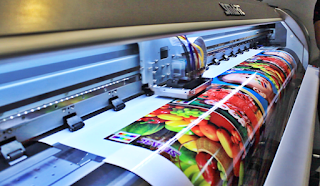Some Myths About Eco-Solvent Ink & Latex ink
Myth 1: The color quality of eco-solvent and latex are very similar.
 There are distinct quality differences between eco-solvent and latex that don't support the idea of the inks having "comparable" color output.
There are distinct quality differences between eco-solvent and latex that don't support the idea of the inks having "comparable" color output.
*Eco solvent has a wider color gamut.
Eco-solvent has a wider color gamut than latex that is especially noticeable in bright red, orange, magenta, blue, cyan and green output. The other significant color difference between the two ink systems is in the "glossy" quality of Eco-solvent. Eco-solvent ink directly interacts with the fibers of the substrate and takes on much of the attributes of the substrate itself. Thus, when printed on glossy substrates it has a vivid, gloss appearance. In contrast, latex inks lie on top of the substrate when printed and have a matt, dull quality, even on glossy materials. In addition, latex simply doesn't compare to the rich blacks and reflective color of Eco-solvent.
*Eco–solvent for richer, smoother color with 7-droplet sizes.
With a latex system, the water-based ink is thinner and more ink must be jetted and dried to achieve the same color density as an Eco-solvent ink system. In addition, Roland's superior variable droplet technology prints Eco-solvent ink in seven different droplet sizes, allowing for finer details, smoother gradations and a less "grainy" appearance when compared to the 12 picoliter fixed dot droplet size of latex.
 Myth 2: Eco-solvent ink is bad for the environment.
Myth 2: Eco-solvent ink is bad for the environment.
The claim that latex is an eco-friendly option, while eco-solvent is the choice for the less environmentally conscious is simply not true. In reality, Sublistar Eco-solvent ink are Certified for low VOC's and indoor safety, the same as latex inks.
*Less ink, less power, less environmental issues.
Because eco-solvent inks are thicker, with more pigment, they need less ink to print a specific color. They also require significantly less heat to cure and less time to print than a latex system. Latex machines require a 220v outlet to run them and users will need special electrical installation. In our opinion, that seems like a lot of power requirements and doesn’t support the latex claim to be more environmentally friendly! In addition, using all that latex ink is not too good for your wallet either – you'll pay considerably more in running costs each year.
More info:
Website: www.skyimagepaper.com
Company Name: Fei Yue Digital Technology Co.,LTD
E-mail: sales@feiyuepaper.com
Tel: 86-025-86628894
Whatsapp: +86 18252072197
Address: Central Road 323, Nanjing, Jiangsu, China
*Eco solvent has a wider color gamut.
Eco-solvent has a wider color gamut than latex that is especially noticeable in bright red, orange, magenta, blue, cyan and green output. The other significant color difference between the two ink systems is in the "glossy" quality of Eco-solvent. Eco-solvent ink directly interacts with the fibers of the substrate and takes on much of the attributes of the substrate itself. Thus, when printed on glossy substrates it has a vivid, gloss appearance. In contrast, latex inks lie on top of the substrate when printed and have a matt, dull quality, even on glossy materials. In addition, latex simply doesn't compare to the rich blacks and reflective color of Eco-solvent.
*Eco–solvent for richer, smoother color with 7-droplet sizes.
With a latex system, the water-based ink is thinner and more ink must be jetted and dried to achieve the same color density as an Eco-solvent ink system. In addition, Roland's superior variable droplet technology prints Eco-solvent ink in seven different droplet sizes, allowing for finer details, smoother gradations and a less "grainy" appearance when compared to the 12 picoliter fixed dot droplet size of latex.
 Myth 2: Eco-solvent ink is bad for the environment.
Myth 2: Eco-solvent ink is bad for the environment.The claim that latex is an eco-friendly option, while eco-solvent is the choice for the less environmentally conscious is simply not true. In reality, Sublistar Eco-solvent ink are Certified for low VOC's and indoor safety, the same as latex inks.
*Less ink, less power, less environmental issues.
Because eco-solvent inks are thicker, with more pigment, they need less ink to print a specific color. They also require significantly less heat to cure and less time to print than a latex system. Latex machines require a 220v outlet to run them and users will need special electrical installation. In our opinion, that seems like a lot of power requirements and doesn’t support the latex claim to be more environmentally friendly! In addition, using all that latex ink is not too good for your wallet either – you'll pay considerably more in running costs each year.
More info:
Website: www.skyimagepaper.com
Company Name: Fei Yue Digital Technology Co.,LTD
E-mail: sales@feiyuepaper.com
Tel: 86-025-86628894
Whatsapp: +86 18252072197
Address: Central Road 323, Nanjing, Jiangsu, China


评论
发表评论